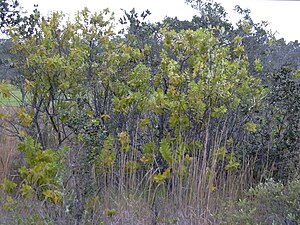
Back جنگلهای خشک حارهای هاوایی Persian Foreste secche tropicali delle Hawaii Italian Гавайские тропические сухие леса Russian Гавайські сухі тропічні ліси Ukrainian
| Hawaiian tropical dry forests | |
|---|---|
 | |
| Ecology | |
| Realm | Oceanian |
| Biome | Tropical and subtropical dry broadleaf forests |
| Borders | |
| Geography | |
| Area | 6,600 km2 (2,500 sq mi) |
| Country | United States |
| State | Hawaii |
| Coordinates | 21°N 157°W / 21°N 157°W |
| Climate type | Hot semi-arid (BSh) and tropical savanna (Aw) |
| Conservation | |
| Conservation status | Critical/Endangered[2] |
| Global 200 | Yes[3] |
Hawaiian tropical dry forests are a tropical dry broadleaf forest ecoregion in the Hawaiian Islands. They cover an area of 6,600 km2 (2,500 sq mi) on the leeward side of the main islands and the summits of Niʻihau and Kahoʻolawe. These forests are either seasonal or sclerophyllous.[2] Annual rainfall is less than 127 cm (50 in) and may be as low as 25 cm (9.8 in).[4] The rainy season there lasts from November to March.[5]
Dominant tree species include koa (Acacia koa), koaiʻa (A. koaia), ʻakoko (Euphorbia spp.), ʻōhiʻa lehua (Metrosideros polymorpha), lonomea (Sapindus oahuensis), māmane (Sophora chrysophylla), loulu (Pritchardia spp.), lama (Diospyros sandwicensis), olopua (Nestegis sandwicensis), wiliwili (Erythrina sandwicensis), and ʻiliahi (Santalum spp.). Endemic plant species include hau heleʻula (Kokia cookei), uhiuhi (Caesalpinia kavaiensis), and Gouania spp. The palila (Loxioides bailleui), a Hawaiian honeycreeper, is restricted to this habitat type.[2]
- ^ "Hawaii Tropical Dry Forests". Bioimages. Vanderbilt University. Retrieved 2011-11-19.
- ^ a b c "Hawaii tropical dry forests". Terrestrial Ecoregions. World Wildlife Fund. Retrieved 2011-11-19.
- ^ Olson, David M.; Eric Dinerstein (2002). "The Global 200: Priority Ecoregions for Global Conservation" (PDF). Annals of the Missouri Botanical Garden. 89 (2): 199–224. doi:10.2307/3298564. JSTOR 3298564.
- ^ World Wildlife Fund, ed. (2001). "Hawaii tropical dry forests". WildWorld Ecoregion Profile. National Geographic Society. Archived from the original on 2010-03-08. Retrieved 2009-02-15.
- ^ "The Hawaiian Islands". Tropical Dry Forests of the Pacific. University of California, Los Angeles. Archived from the original on 2009-12-24. Retrieved 2009-02-15.